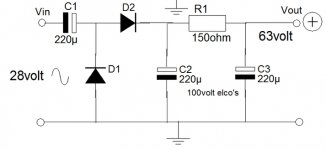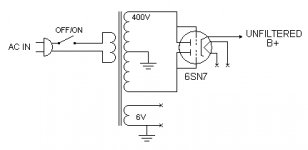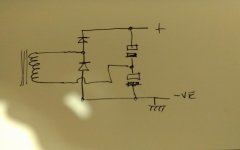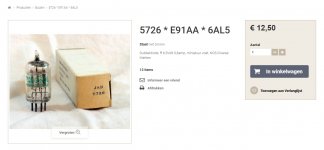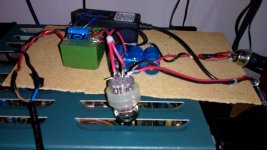I'm wondering if someone has experimented using a triode as diode (by connecting the grid to the plate). I'm using a half wave voltage doubler like attached as HT for my preamp. It uses 2 pieces of 1N4007 diodes to do the job. What would happen if I use say ECC82 wired for 2 separate tube diodes instead of the 1N4007's?
I guess there will be some extra voltage drop. But apart from that, will it work just the same? Any ideas about the 'audiophile' benefits?
Does such a tube single diode need some minimum voltage or will it work the same for a range of say 20-100V from the transformer?
Of course I could use EZ80 etc as tube rectifier but that needs another transformer with double windings. For this circuit I would need 2x 60V windings (to keep below 100V after rectification) and that is not easy to get with small footprint (only few ma's). I try to use tube rectification while keeping the same single winding transformer.
I've googled on 'using triodes as diodes' and 'voltage doubler with tubes' but no interesting material shows up. Strange.
I guess there will be some extra voltage drop. But apart from that, will it work just the same? Any ideas about the 'audiophile' benefits?
Does such a tube single diode need some minimum voltage or will it work the same for a range of say 20-100V from the transformer?
Of course I could use EZ80 etc as tube rectifier but that needs another transformer with double windings. For this circuit I would need 2x 60V windings (to keep below 100V after rectification) and that is not easy to get with small footprint (only few ma's). I try to use tube rectification while keeping the same single winding transformer.
I've googled on 'using triodes as diodes' and 'voltage doubler with tubes' but no interesting material shows up. Strange.
Attachments
However, if I had 4007 then, I would rather used it.
Right, nothing can match 1N4007 for ease and costs (and fat chance it sounds okay too). Just a matter of experimenting around. But your guess is it should work?
How much current do you need?
An ECC82 will get you about 10ma and an ECC84 or PCC84 will get you 12ma. 'Audio' double triodes are an expensive way to go though.
A humble 6H6 / 12H6 or 6AL5 / 12AL5 (double diode) will make 8ma at 250v no problem. Do not forget you will need to supply the heater too.
Yes it will work just the same and yes there will be more voltage drop. You will have to determine that by experiment. Will it sound better? Doubt it.
An ECC82 will get you about 10ma and an ECC84 or PCC84 will get you 12ma. 'Audio' double triodes are an expensive way to go though.
A humble 6H6 / 12H6 or 6AL5 / 12AL5 (double diode) will make 8ma at 250v no problem. Do not forget you will need to supply the heater too.
Yes it will work just the same and yes there will be more voltage drop. You will have to determine that by experiment. Will it sound better? Doubt it.
How much current do you need?
An ECC82 will get you about 10ma and an ECC84 or PCC84 will get you 12ma. 'Audio' double triodes are an expensive way to go though.
A humble 6H6 / 12H6 or 6AL5 / 12AL5 (double diode) will make 8ma at 250v no problem. Do not forget you will need to supply the heater too.
Yes it will work just the same and yes there will be more voltage drop. You will have to determine that by experiment. Will it sound better? Doubt it.
Thanks for the reply, that's usefull. I need only about 6mA so no problem here. About the expensiveness issue: I have plenty of ECC's lying idle and need to buy/look for the other types you mention.
About the extra heater waste: yes that's completely crazy of course. But I have a 12V smps 5Amps in the enclosure too so these things are cheap and work fine as heater / filament supply. Well these issues with tubes are hardly about rationality.
I'm sceptical about the better sound too, but only one way to find out ...
Last edited:
If you have them that's the cheapest way!
Why did you choose the 1/2 wave doubler?
If you do not need to have the transformer connected to ground, this has better regulation and faster 'charge' time and same parts count.
Sorry for the poor picture, I only have my phone and envelope with me!
Why did you choose the 1/2 wave doubler?
If you do not need to have the transformer connected to ground, this has better regulation and faster 'charge' time and same parts count.
Sorry for the poor picture, I only have my phone and envelope with me!
Attachments
Thanks, could use that too indeed. Just saw the other one where a guy named TubeJack used this power supply to power a tube in his modded Akai tuner with good results. When adding some R-C's after this you will have a bigger parts count. Anyway, the other one with 1n4007 works just fine, no hum to be heard.
I've used 6AS7 and 5687s as rectifiers. Only experimented with it, never used in an actual circuits. My plan was to use 6AS7 rectifiers in guitar amps and control the rp (and b+ sag) for added sustain. But I never got that far.
The heater-cathode voltage limit should not be exceeded (which is 300V for 6AS7s) but what about the grid-cathode voltage? Not sure all triodes will survive for long if grid is tied to plate in a high voltage supply. ?
The heater-cathode voltage limit should not be exceeded (which is 300V for 6AS7s) but what about the grid-cathode voltage? Not sure all triodes will survive for long if grid is tied to plate in a high voltage supply. ?
..... 6AL5 / 12AL5 (double diode) will make 8ma at 250v no problem. .....
This.
The 6 volt part is common as dirt and just as cheap, around here at least. The 6 volt JAN number is 5726; the 12 volt escapes me at the moment, it's not nearly as common.
Win W5JAG
working prototype
Works as expected. Used cheap China ECC82 as rectifier (once bought for around $8). Cheap SMPS 1A 12V, ebay $2. Small print transformer 36V~. Gives around 110V after rectification when using one ECC82 in preamp itself. I had to substitute my 6SN7 because the SMPS couldn't do the job anymore, it sagged down to around 6V and voltage after rectification dropped down to 60V or so (probably because the way too low heater supply the diodes don't work as well anymore).
Anyway, the basic idea works. A matter of some more experimenting to get it right.
Works as expected. Used cheap China ECC82 as rectifier (once bought for around $8). Cheap SMPS 1A 12V, ebay $2. Small print transformer 36V~. Gives around 110V after rectification when using one ECC82 in preamp itself. I had to substitute my 6SN7 because the SMPS couldn't do the job anymore, it sagged down to around 6V and voltage after rectification dropped down to 60V or so (probably because the way too low heater supply the diodes don't work as well anymore).
Anyway, the basic idea works. A matter of some more experimenting to get it right.
Attachments
We knew it would!
I guess there is something quite wrong with the SMPS, it only has to supply 0.15A at 12 volts for an ECC82. Yet can do 0.8A at 6 volts for the 6SN7?
You could wire the ECC82 for 6 volt operation too.
Another thing to consider is bending the valve pins usually leads to a leak and failure in the future. As many of us who have tried to straighten a bent pin will know...
I guess there is something quite wrong with the SMPS, it only has to supply 0.15A at 12 volts for an ECC82. Yet can do 0.8A at 6 volts for the 6SN7?
You could wire the ECC82 for 6 volt operation too.
Another thing to consider is bending the valve pins usually leads to a leak and failure in the future. As many of us who have tried to straighten a bent pin will know...
We knew it would!
I guess there is something quite wrong with the SMPS, it only has to supply 0.15A at 12 volts for an ECC82. Yet can do 0.8A at 6 volts for the 6SN7?
You could wire the ECC82 for 6 volt operation too.
It is 0.15A and 0.6A (6SN7 at 6V) down the line, so 0.75 in total. I guessed it should have worked, but it doesn't. So not the best SMPS around, but hey just $2.
Another thing to consider is bending the valve pins usually leads to a leak and failure in the future. As many of us who have tried to straighten a bent pin will know...
That's why it's called a prototype. I hadn't a spare noval-socket at hand. But will cater for this some time in the future.
Yes 6SN7 = 0.6A at 6 volts is correct. Typo sorry.
But a bit confused by ''It is 0.15A and 0.6A (6SN7 at 6V) down the line, so 0.75 in total. ''
ECC82 is 0.15A in series connection (for 12 volts) and 0.3A in parallel connection (for 6 volts). So will be 0.9A @ 6 volts?
Okay, but this is not about the power supply / topic per se. The 2 diodes are one ECC82 which is running at 12V and 0.15A. From there on the proper pre-amp is fed with the 12V and brought down to 6V for the 6SN7 hence 0.6A (I can control this voltage from 1.25 to 12V). I could have chosen 12SN7 or 12SX7 but these are more scarce. In that case I would have had 0.15 + 0.30 at 12V and this would have been less of a problem for the so-so SMPS.
BTW: I installed a SMPS that's more heavy at 12V/5A and everything works fine.
- Status
- This old topic is closed. If you want to reopen this topic, contact a moderator using the "Report Post" button.
- Home
- Amplifiers
- Tubes / Valves
- use double triode as rectifier
